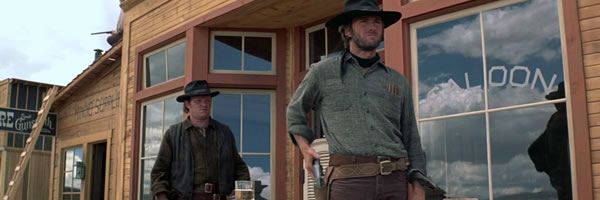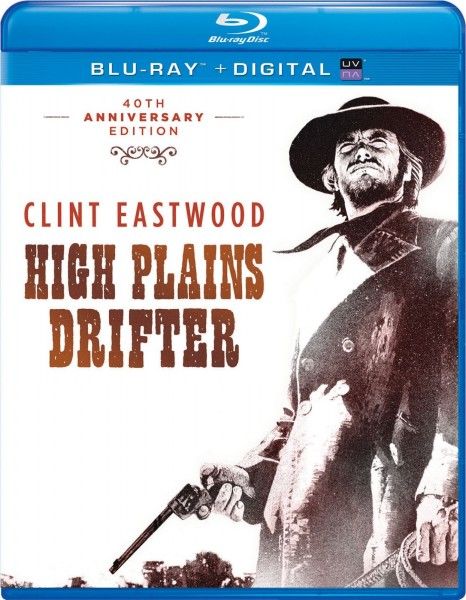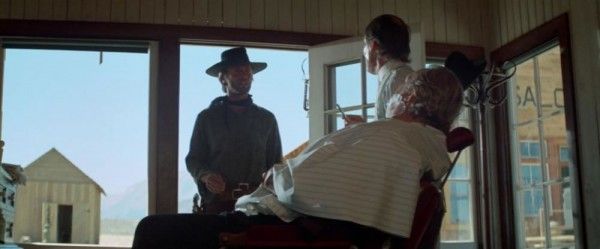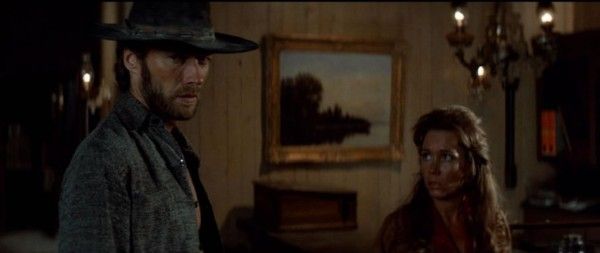It's amazing to consider how prolific Clint Eastwood has been as a director. When actors direct, they tend to focus on just a few projects. Kevin Costner, for instance, has just three directing credits to his name. Mel Gibson has four. And yet it took Eastwood almost twenty films before he received the same accolades that they did for his skills. (He currently stands at 35-plus movies.) It took him that long to be properly acknowledged. Luckily, because he has so many, we can genuinely chart his growth and progress as a creative force in ways we can't with those other filmmaker/stars. High Plains Drifter, which has arrived in freshly minted Blu-ray form, was the first Western he directed, and remains one of his most challenging (and disturbing) efforts behind the camera. Hit the jump for my full review.
It's a far cry from more confident and polished directing jobs waiting in his future. Unforgiven and its ilk reflect a poise that we simply don't see here. But the raw strength of his vision is more readily apparent in High Plains Drifter: the understanding of the medium's power to affect us. It's crude and sometimes shocking for its own sake, but it demands our attention from the get-go and refuses to go easy on us.
Eastwood relies a great deal on his mentors Sergio Leone and Don Siegel to convey that power. You can spot their sensibilities in the harsh and merciless landscape on display, as well as the equally harsh figures moving through it. The Western was well into its nihilistic postmodern phase when High Plains Drifter came out, fed by Leone's Fistful trilogy and the larger social upheavals of the late 1960s. This was a western for a post-Vietnam world, where hope lay dying and hypocrisy seemed to be the only reliable constant. Small wonder Drifter rankled so many people. John Wayne thought it was vile, and after watching what Eastwood's title character does to the town of Lago, it's not hard to see where he was coming from.
The town's residents stink of cowardice and evasion, terrified of a trio of outlaws while complicity aiding them in their subversion of anything resembling decency. When Eastwood's unnamed gunslinger arrives in town, he does so less as a force for justice than as the townspeople's own evils turned back against them. Within ten minutes, he's raped one occupant and gunned down several more. Even when the citizens hire him to protect them from a trio of outlaws -- whom they themselves betrayed after they killed the local Marshall at their behest -- he seems to do so for his own inscrutable reasons rather than theirs.
The harshness of this world is shocking. It bears a resemblance to Leone's A Fistful of Dollars and even more temperate efforts like The Man Who Shot Liberty Valance, but takes their implicit themes to their logical extreme. This isn't a world where good people can make a difference; they only sit by helplessly while the vermin screech at each other over the scraps. Eastwood's stranger is a purging force of destruction, wiping out the corruption with the same moral bankruptcy that created it. Only his comparative honesty about it sets him apart. There's a catharsis in the way he tears everything down around him, but it's not replaced by anything cleaner or better.
That's a grim vision, and it certainly proves troubling for anyone used to the older white-hat/black-hat distinctions of classic Westerns. Modern audiences may have difficulty swallowing other parts of the story, such as the casual misogyny or Eastwood's willingness to belabor his point at times. But it's hard to dismiss just how damn effective it can be. Eastwood shows a penchant for arresting images, starting with the first shot where the stranger rides out of the desert haze and continuing through the hellfire and brimstone that follow.
He marries that to his signature restraint with surprising deftness, especially considering that this was only his third time in the director's chair. He's willing to leave a lot of questions unanswered: to leave the mystery be and allow the audience to draw their own conclusions. Is the stranger an avenging ghost? An obsessed relative of the dead marshal? How do his motivations tie in to the merciless punishment he inflicts on this town? The director gives us hints, but refuses to spell it out for us.
In the process, he demonstrates a respect for his audience that has all but vanished from the screens these days. He wants to fully engage us in the story: to let us find our own answers instead of being spoon fed them. Considering how bleak and seemingly hopeless a movie this is, that's a bold choice. But it helps High Plains Drifter maintain its power, both as a statement of the era in which it was made and as a more timeless entry in the canon of Western classics. High Plains Drifter certainly isn't for everyone, and Eastwood did better both as an actor and a director. But that only confirms just what an extraordinary filmmaking talent he was. The film suffers solely in comparison to the very highest of standards, and as the poster implies, it remains impossible to forget even after all these years.
The new Blu-ray is a testament to the same sensibilities that crafted the film itself: strong, but utterly minimalist. Indeed, there are no extra features at all; just the movie and an indifferent trailer. The transfer, however, is gorgeous, bringing the film's visual strengths to the fore and rendering the experience of viewing it as hypnotically powerful as anyone could hope for. In some ways, that's better than a disc that carries a lot of bells and whistles. Eastwood always followed the "less is more" school of filmmaking. Why should this new Blu-ray be any different?




